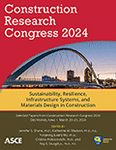Origami Housing: A Post-Disaster Temporary Emergency Housing Solution
Publication: Construction Research Congress 2024
ABSTRACT
Over the last two decades, natural disasters have caused over $2.97 trillion in economic losses, 1.23 million deaths, and affected more than 4 billion people through injury, loss of housing, displacement, and/or requiring emergency aid. Data have shown that physical, social, and economic inequities play a significant role in the vulnerability of communities particularly post-disasters. Low-income communities have more than four times as many deaths per disaster, experience more severe and long-lasting infrastructure damage, and often receive delayed disaster recovery. Therefore, this causes prolonged and widespread homelessness as well as an inevitable temporary housing crisis. This research proposes an innovative short-term Origami temporary emergency housing solution, which offers an equitable and affordable solution ensuring potential victims are offered quick shelter post-disasters. This study aims to address the challenges of post-disaster homelessness through (1) understanding existing natural disaster housing solutions, (2) identifying post-disaster vulnerabilities pertaining to temporary housing needs, and (3) proposing Origami shelter solution and validating its feasibility and applicability through surveying engineering and architecture experts. The results of this study show the urgency for quick-assembly temporary emergency housing that allows victims to safely live and return to routine activities while infrastructure systems and homes are being repaired or rebuilt.
Get full access to this article
View all available purchase options and get full access to this chapter.
REFERENCES
Araya, F., K. M. Faust, and J. A. Kaminsky. 2019. “Public perceptions from hosting communities: The impact of displaced persons on critical infrastructure.” Sustain Cities Soc, 48. Elsevier Ltd. https://doi.org/10.1016/j.scs.2019.101508.
Burck, L., M. Kong, and P. Januário. 2015. “Paper Architecture inspired in Origami and Emergency Temporary Architecture.” 3rd Annual International Conference on Architecture and CIvil Engineering (ACE 2015).
Dhakal, S., and L. Zhang. 2022. “Integrating Social Equity and Vulnerability with Infrastructure Resilience Assessment.” Construction Research Congress 2022.
Hendriks, E., and A. Opdyke. 2022. “The influence of technical assistance and funding on perceptions of post-disaster housing safety after the 2015 Gorkha earthquakes in Nepal.” International Journal of Disaster Risk Reduction, 73. Elsevier Ltd. https://doi.org/10.1016/j.ijdrr.2022.102906.
Home Harmonizing. n.d. “The flat-packed ‘Compact Shelter’ by Alastair Pryor.” Accessed April 27, 2023. https://homeharmonizing.com/flat-packed-compact-shelter-pops-up-to-morph-into-an-emergency-habitable-unit/.
IFRC (International Federation of Red Cross and Red Crescent Societies). 2020. World disasters report 2020: Come Heat or High Water. Geneva.
INDECI. 2007. Movimiento Sísmico afecta severamente Departamentos de Ica y Sur de Lima: Informe de emergencia N°322, 16/09/2007. Lima.
Lindell, M. K., and C. S. Prater. 2003. “Assessing Community Impacts of Natural Disasters.” Nat Hazards Rev, 4 (4): 176–185. https://doi.org/10.1061/ASCE1527-698820034:4176.
Llorente-Marrón, M., M. Díaz-Fernández, P. Méndez-Rodríguez, and R. G. Arias. 2020. “Social vulnerability, gender and disasters. The case of Haiti in 2010.” Sustainability (Switzerland), 12 (9). MDPI. https://doi.org/10.3390/SU12093574.
Mannheim, V., and Z. Simenfalvi. 2020. “Total life cycle of polypropylene products: Reducing environmental impacts in the manufacturing phase.” Polymers (Basel), 12 (9). MDPI AG. https://doi.org/10.3390/POLYM12091901.
Masozera, M., M. Bailey, and C. Kerchner. 2007. “Distribution of impacts of natural disasters across income groups: A case study of New Orleans.” Ecological Economics, 63 (2–3): 299–306. https://doi.org/10.1016/j.ecolecon.2006.06.013.
Mastroianni, E., J. Lancaster, B. Korkmann, A. Opdyke, and W. Beitelmal. 2021. “Mitigating infrastructure disaster losses through asset management practices in the Middle East and North Africa region.” International Journal of Disaster Risk Reduction, 53. Elsevier Ltd. https://doi.org/10.1016/j.ijdrr.2020.102011.
Pradhananga, P., C. Calle Müller, R. Rahat, and M. Elzomor. 2023. “Investigating the Need for Forensic Engineering Graduate Program to Meet the Growing Workforce Demand.” 2023 ASEE Annual Conference & Exposition.
Pradhananga, P., A. Elawady, and M. ElZomor. 2022. “Leveraging Informal Learning Pedagogies to Empower Coastal Communities for Disaster Preparedness.” Front Built Environ, 8. Frontiers Media S.A. https://doi.org/10.3389/fbuil.2022.883198.
Rendon, C., K. K. Osman, and K. M. Faust. 2021. “Path towards community resilience: Examining stakeholders’ coordination at the intersection of the built, natural, and social systems.” Sustain Cities Soc, 68. Elsevier Ltd. https://doi.org/10.1016/j.scs.2021.102774.
Rose, J., and K. Chmutina. 2021. “Developing disaster risk reduction skills among informal construction workers in Nepal.” Disasters, 45 (3): 627–646. Blackwell Publishing Ltd. https://doi.org/10.1111/disa.12435.
San Bartolomé, A., D. Quiun, and L. Zegarra. 2008. “Performance of Reinforced Adobe Houses in Pisco, Peru Earthquake.” The 14th World Conference on Earthquake Engineering.
Shrestha, N. 2021. “Factor Analysis as a Tool for Survey Analysis.” Am J Appl Math Stat, 9 (1): 4–11. Science and Education Publishing Co., Ltd. https://doi.org/10.12691/ajams-9-1-2.
Soleimani, K., and M. Matini. 2022. Reusing Earthquake Rubble in a Temporary Housing Structure for Hot Arid Climates. https://doi.org/10.1061/(ASCE).
UNDRR CRED. 2020. Human Cost of Disasters: An Overview of the last 20 years 2000-2019. CRED, UNDRR, Brussels.
Information & Authors
Information
Published In
History
Published online: Mar 18, 2024
Authors
Metrics & Citations
Metrics
Citations
Download citation
If you have the appropriate software installed, you can download article citation data to the citation manager of your choice. Simply select your manager software from the list below and click Download.
